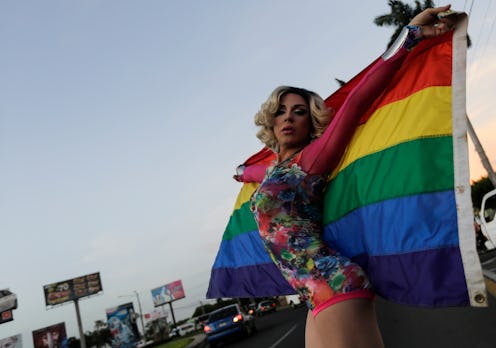When it comes to celebrating Pride Month, there's a lot of history left to explore. Sure, I love glitter and rainbows as much as the next person, but I have to admit, I was pretty surprised when I learned a lot of facts about LGBTQ Pride Month myself. Pride Month is meant to celebrate and honor the LGBTQ community, which feels especially significant in light of the recent, horrific attacks on the queer community in Orlando. But although it's true that the Pride Parade is one big, huge party and that Pride Month is a great time to go to LGBTQ bars and clubs for happy hour and dancing — there really is no celebration quite like Pride Month — it's important to remember that Pride is actually the result of decades of hard work and advocacy to protect the LGBTQ community and make the world a more inclusive place. All of which is to say, some of the facts you may not know about Pride might totally change your perception of the month-long event.
Pride can mean different things to different people, even within the same community. Some LGBTQ people never attend a Pride event. Some go with their children, their parents, their friends. Some go alone, with their office, or with their pets (there is nothing cuter than a dog in a rainbow bowtie, am I right?). But no matter who you are or how you identify, Pride is one thing for certain: A space full of acceptance and community. For many queer people, Pride is the first time you feel surrounded by people you relate to and who you feel can really understand you and your experiences.
It's always good, no matter what your personal experience with Pride is, to learn about your history and see how it all came together. Check out the list of surprising facts about Pride Month below to learn more:
1. Pride Commemorates The Stonewall Inn Riots
If you're familiar with queer culture, you've probably heard about The Stonewall Inn, located in New York City's Greenwich Village. At the time of the riots (1968, to be exact), New York state laws prohibited homosexuality in public, so the LGBTQ community had to find secret, private safe spaces to meet — places like Stonewall. Unfortunately, these safe spaces were often raided by the police. But during one of these raids, the LGBTQ community of Stonewall began fighting back, leading to a series of demonstrations known as the Stonewall riots. In turn, the riots sparked discussions about the gay community and gay rights, in part leading to the Pride movement.
2. The Stonewall Inn Was Owned By The Mob
I know it sounds bizarre, but this is totally true: The Stonewall Inn was actually owned by people in the mafia. Members of the mob basically saw a business opportunity when they realized that LGBTQ people were being routinely turned away from other bars and clubs. The mob purchased Stonewall (originally a straight bar) and allegedly paid off local police to turn a blind eye to the queer community having such a presence in the establishment.
3. The Stonewall Inn Was Also Technically A "Private Club"
To avoid local liquor laws that prohibited serving alcohol to the LGBTQ community, Stonewall had patrons sign a guest book (usually with pseudonyms) under the guise of the establishment functioning as a private "bottle club," as opposed to a standard bar.
4. The Lambda Symbol Is Also A Symbol Of Gay Rights
Most people are familiar with the rainbow flag as a sign of LGBTQ rights. Interestingly, the Lambda symbol is also a traditional sign of queer equality. For instance, lambda (from the Greek alphabet) is typically associated with finding balance and equality. This makes sense in terms of the Pride movement, where people are striving to find balance and equality in society.
5. The First Pride Flag Debuted In 1978
Speaking of the Pride Flag, the first one made its debut in 1978. Designed by San Francisco artist Gilbert Baker, the original Pride Flag contained eight colors with coordinating symbols for each. At the time of the Flag's creation, they broke down like this: Pink (sexuality), Red (life), Orange (healing), Yellow (sunlight), Green (nature), Turquoise (magic/art), Blue (serenity/harmony) and violet (spirit). Pretty cool, right?
6. Transgender Women of Color Played A Huge Role In Pride
Transgender women of color played a massive role in the origins of Pride. For example, Sylvia Rivera, a bisexual transgender woman of Puerto Rican and Venezuelan decent, and Marsha P. Johnson, a black transgender woman, were both at the forefront of the Stonewall conflict, fighting for LGBTQ rights and equality. Specifically, both women advocated for space in the community for the transgender population, sex workers, and others who desperately needed legal protections and societal acceptance.
Images: Giphy (6)
